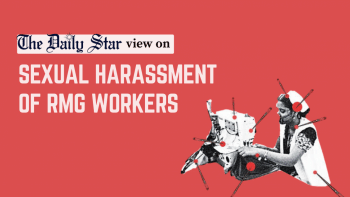Why is sexual harassment at workplaces still the norm?

Sexual harassment, prevalent in both formal and informal sectors, has been a major deterrent to women's greater participation in the workforce. This form of abuse is not only limited to the workplace; it is seemingly all-pervasive. It takes place, for instance, both on the way to work and in the areas they live, constricting the lives of those who wish to work.
Among the 60.8 million employed, an estimated 5.5 percent have experienced sexual abuse (7.4 percent urban women), and such abuse was particularly prevalent in the industries. This figure is most likely a gross underreporting. The Report on Violence Against Women (VAW) Survey 2015 for Bangladesh showed that 76.8 percent of physical violence took place in the husband's house, while 21.9 percent took place at the workplace. This just shows how grim the scenario is.
However, data on the frequency of sexual harassment at workplaces is varied, because definitions and perceptions vary. It is a sensitive subject that is not easily captured in a survey, and the situation differs greatly depending on the type of workplaces surveyed.
Brac Institute of Governance and Development (BIGD) in collaboration with Institute of Development Studies (IDS) conducted research on "The gendered price of precarity: Young women navigating workplace sexual harassment" to study the experiences, voices, and agency of women working as domestic workers and agro-processing firm workers. The research found that there is a general awareness of workplace sexual harassment, although the language to articulate it is limited.
The experience of harassment is prevalent, with women and girls taking various strategies to prevent and cope with it, both at work and during the commute to work. If the abuse reaches a certain unacceptable level, the women leave the job or take various informal strategies to complain or deal with the perpetrator.
Meanwhile, gender-based violence (GBV) has been a key concern since the early days of the ready-made garment (RMG) industry. A combination of complete control of managers over workers, and fear of losing their job has stopped workers from using formal channels to file official complaints or even voicing their grievances. In the early years of the sector, this was compounded by a lack of fair complaint mechanisms. Thus, sexual harassment and GBV became deeply enmeshed and normalised within the workplace environment of factories.
A large portion of female garment workers are migrants from rural areas and poor families, which means that they do not have local social support networks. At the workplace, supervisors are mostly male, which creates power imbalances, making the women more vulnerable and also less able to complain. Women employees remain in danger of various types of violence despite the fact that entry to the formal economy through the RMG industry has been economically beneficial for many women, as they attain steady employment. The Fair Wear Foundation found that 75 percent of female garment workers had experienced verbal violence at work, 30 percent experienced psychological violence and 20 percent physical violence.
While Bangladesh still has to ratify the ILO Violence and Harassment Convention, 2019 (C190), government policies and laws have already recognised the importance of making sure that workplaces remain free of all forms of harassment and abuse, including sexual harassment.
The national action plans for National Women's Development Policy and to eliminate violence against women recognise the importance of addressing and ending sexual harassment at the workplace. Besides, in 2009, a High Court directive formulated guidelines to stop sexual harassment in educational institutions and workplaces. This included raising awareness and setting up prevention and complaints committees at all workplaces and educational institutions.
However, implementation is weak and even workplaces that have set up such committees have not been able to make them functional.
While there is increased knowledge about workplace sexual harassment in the RMG sector, we know much less about other formal sectors, the public sector, and the least about informal sectors, where the majority of women work. The BIGD/IDS research has brought out the dimensions related to the naming and protesting of such behaviour, but there is a need to expand and deepen the research on this topic to understand the variations, opportunities, and constraints for reducing such behaviour. Such an endeavour is also vital to establish complaint mechanisms, ensuring that women can avail opportunities to complain and seek redress.
Maheen Sultan is a senior fellow of practice at Brac Institute of Governance and Development (BIGD), and a member of Naripokkho.
Views expressed in this article are the author's own.
Follow The Daily Star Opinion on Facebook for the latest opinions, commentaries and analyses by experts and professionals. To contribute your article or letter to The Daily Star Opinion, see our guidelines for submission.

 For all latest news, follow The Daily Star's Google News channel.
For all latest news, follow The Daily Star's Google News channel. 











Comments